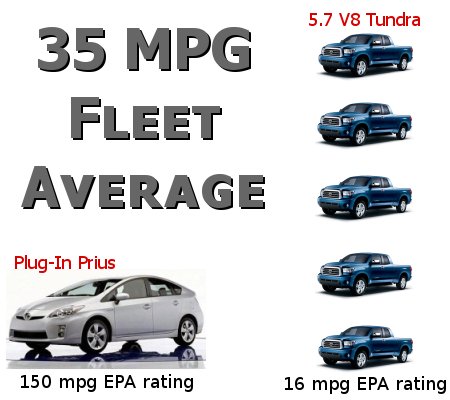New Fuel Economy Rules Won’t Stop Big Trucks – Big V8s Are Here Forever
Jason Lancaster | May 20, 2009 | Comments 6
The Obama administration seems to have solidified the direction of fuel economy and emissions regulations for the next decade. Here’s the basics of the plan laid down yesterday:
- An automaker’s “fleet average” – i.e. the average fuel economy of all the vehicles an automaker sells adjusted by sales volume – must be 35.5 mpg by 2016 (up from 2009’s fleet requirement of 25 mpg).
- CO2 emissions have to drop to 250 grams per mile (down from 380).
- Plug-in electric and hydrogen powered vehicles will qualify for “super credits” – meaning that selling one plug-in electric and/or hydrogen powered vehicle will cancel out 2 or more “regular” vehicles.
These new rules are great for the environment and widely popular, and considering that all the auto manufacturers have signed off on the plan (as well as the UAW), this looks as good as done. So, the question for us is, What do these new fuel economy and emissions rules mean for pickup trucks?
Contrary to popular belief, these new rules won’t necessarily result in more fuel efficient trucks, nor will they significantly impact truck sales. Because the fuel economy and emissions rules are “fleet averages,” there’s plenty of wiggle room for big trucks and SUVs. In a nutshell, a “fleet average” allows an auto manufacturer to make vehicles with poor fuel economy just so long as they make enough vehicles with really good fuel economy to offset them. Make sense? Check out the graphic below.

New fuel economy rules won't effect truck sales nearly as much as some think. One 150 mpg plug-in Prius can balance out 5 new 16 mpg Tundras.
The math is pretty simple. For every plug-in Prius that Toyota sells (which could be rated as high as the Volt, which Chevy claims at 150 mpg) they can sell 5 Tundras with “fuel economy” room to spare. Using EPA ratings of 16 mpg for the Tundra and 150 mpg for the plug-in Prius, the “fleet average” is 38.33 mpg! That’s what Obama means when he talks about “super credits” – super credits mean that one plug-in is going to be super for truck sales.
Of course, the plug-in Prius might not get the 150 mpg rating. If the new plug-in Prius only rates 100 mpg, Toyota can sell 3 Tundras for every plug-in and still come out above the required average. Toyota isn’t alone either. Chevy has the Volt, and Ford and Chrysler are both planning on selling plug-ins.
Even if you take the plug-ins out of the equation and just look at regular hybrids, the ratio is just about 1 to 1. For every 50 mpg 2010+ Prius that Toyota sells, they can sell one fuel guzzling 16 mpg Tundra. Toyota sold about 159k Prius in 2008, which just about makes up for each and every Tundra.
If you’re good with numbers, you’ve probably come to the conclusion by now that our math is a little “simple.” We’re not factoring in other vehicles like the Tacoma, the Highlander, the 4Runner, etc. all of which get less than 35 mpg. True. We’re also not factoring in the Corolla (350k sold in 2008), Camry (430k sold in 2008), Yaris, tiny little Scions, etc., all of which can be made to attain 35 mpg + with relative ease.
It’s also true that the exact rules have yet to be disclosed. Still, the point we’re trying to make stands tall: Fleet average fuel economy ratings can be manipulated by clever auto manufacturers.
Toyota’s situation is better than Ford, GM, and Dodge (the other companies offering big pickups in any substantial volume), but every auto manufacturer can overcome the fleet fuel economy challenge. The trick is getting a plug-in hybrid to sell that qualifies for “super credits” that will cancel out all the thirsty big trucks and SUVs. If manufacturers get creative and “tax” pickups by subsidizing the cost of plug-in vehicles with additional mark-up on trucks – adding $1000 to 5 Tundras in order to cut the cost of a new plug-in Prius by $5k – they’ll be able to meet the sales figures they need to hit their fuel economy number.
Trucks are here to stay (just as they should be). All you haters can snap out of it now.
Filed Under: Auto News


Some of this legislation stuff is pure crap. It’s not going to eliminate what’s already out there and you can’t just phase out people’s trucks when they need it for work. Demand will overpower it and I’d really like to see if it is enforced.
Word.
Tell them to bring it on. Between them and the water police here in Jax in which I will go against. Well I get already over 20mpg and that won’t sit well with Obama’s group.
Maybe if I buy a Civic and race the crap out of it to only get 13 MPG it will shut people up.
Stupid politicians! Hey if we all had plug in hybrids all the problems would be solved … it is not that simple! Yeah let’s just plug our cars in to the over taxed power grid. Here in Cali if your electric bill is higher than your last years bill they hit you with additional charges. Last year we had rolling blackouts due to lack of power so we need to add power plants to our system. We need to build renewable power plants like a big solar field in the Mojave Desert, nope can not do that because of the Endangered Species Act … I need to stop now before I begin to rant and get way off subject.
You hit it mike. The power grid can’t handle it.